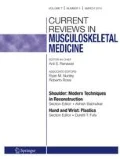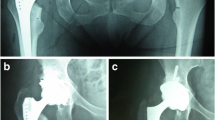Abstract
Dislocation remains one of the most common complications after total hip arthroplasty, regardless of the surgical approach. While multiple reasons as laxity, implant position, improper implant choice, and impingement etc. might be leading factors for dislocation, an exact identification of the exact reason is of major importance, to plan for a proper surgical or nonsurgical correction. This article describes in detail the definition, etiology, reduction, and possible treatment options for dislocation after primary and revision total hip arthroplasty that are currently used at the Endo Klinik in Hamburg. It furthermore includes a distinct overview of possible surgical treatment options, based on the main pathology leading to dislocation.


Similar content being viewed by others
References
Papers of particular interest, published recently, have been highlighted as: • Of importance
Biedermann R, Tonin A, Krismer M, Rachbauer F, Eibl G, Stöckl B. Reducing the risk of dislocation after total hip arthroplasty: the effect of orientation of the acetabular component. J Bone Joint Surg Br. 2005;87:762–9.
Swedish Hip Arthroplasty Register, Annual Report 2011, http://www.shpr.se.
• Hailer NP, Weiss RJ, Stark A, Kärrholm J. The risk of revision due to dislocation after total hip arthroplasty depends on surgical approach, femoral head size, sex, and primary diagnosis. An analysis of 78,098 operations in the Swedish Hip Arthroplasty Register. Acta Orthop. 2012;83:442–8. Patients undergoing THA after femoral neck fracture or osteonecrosis are at higher risk of dislocation. The use of the minimally invasive or posterior approaches increases this risk of dislocations. Consequently, the question is raised whether patients belonging to these risk groups should be operated using lateral approaches.
Devane PA, Wraighte PJ, Ong DC, Horne JG. Do joint registries report true rates of hip dislocation? Clin Orthop Relat Res. 2012;470:3003–6.
Moskal JT, Capps SG. Acetabular component positioning in total hip arthroplasty: an evidence-based analysis. J Arthroplasty. 2011;26:1432–7.
Sikes CV, Lai LP, Schreiber M, Mont MA, Jinnah RH, Seyler TM. Instability after total hip arthroplasty: treatment with large femoral heads vs constrained liners. J Arthroplasty. 2008;23(7 Suppl):59–63.
Patel PD, Potts A, Froimson MI. The dislocating hip arthroplasty: prevention and treatment. J Arthroplasty. 2007;22(4 Suppl 1):86–90.
Ranawat CS, Rao RR, Rodriguez JA, Bhende HS. Correction of limb-length inequality during total hip arthroplasty. J Arthroplasty. 2001;16:715–20.
Amstutz HC, Le Duff MJ, Beaule PE. Prevention and treatment of dislocation after total hip replacement using large diameter balls. Clin Orthop Relat Res. 2004;108.
Amuwa C, Dorr LD. The combined anteversion technique for acetabular component anteversion. J Arthroplasty. 2008;23:1068.
Fukunishi S, Fukui T, Nishio S, Fujihara Y, Okahisa S, Yoshiya S. Combined anteversion of the total hip arthroplasty implanted with image-free cup navigation and without stem navigation. Orthop Rev. 2012;4:e33.
Meftah M, Yadav A, Wong AC, Ranawat AS, Ranawat CS. A novel method for accurate and reproducible functional cup positioning in total hip arthroplasty. J Arthroplasty. 2013;28:1200–5.
Queally JM, Abdulkarim A, Mulhall KJ. Total hip replacement in patients with neurological conditions. J Bone Joint Surg Br. 2009;91:1267–73.
Peters CL, McPherson E, Jackson JD, et al. Reduction in early dislocation rate with large-diameter femoral heads in primary total hip arthroplasty. J Arthroplasty. 2007;22(6 Suppl 2):140.
Rodriguez JA, Rathod PA. Large diameter heads: is bigger always better? J Bone Joint Surg Br. 2012;94(11 Suppl A):52–4.
Lewinnek GE, Lewis JL, Tarr R, Compere CL, Zimmerman JR. Dislocations after total hip-replacement arthroplasties. J Bone Joint Surg Am. 1978;60:217–20.
Archbold HAP, Mockford B, Molloy D, et al. The transverse acetabular ligament, an aid to acetabular component placement during total hip arthroplasty. J Bone Joint Surg Br. 2006;88:883.
Widmer KH, Zurfluh B. Compliant positioning of total hip components for optimal range of motion. J Orthop Res. 2004;22:815–21.
• Garbuz DS, Masri BA, Duncan CP, Greidanus NV, Bohm ER, Petrak MJ, et al. The Frank Stinchfield Award: dislocation in revision THA: do large heads (36 and 40 mm) result in reduced dislocation rates in a randomized clinical trial? Clin Orthop Relat Res. 2012;470:351–6. This paper demonstrates nicely, that in revision scenarios, larger head sizes as 36 mm or 40 mm are able to reduce the dislocation rates. This was compared with a 32 mm comparative patient cohort. In the same time, there was no different in quality of life measures in both groups.
Gaines RJ, Hardenbrook M. Closed reduction of a dislocated total hip arthroplasty with a constrained acetabular component. Am J Orthop. 2009;38:523–5.
Schafer SJ, Anglen JO. The East Baltimore Lift: a simple and effective method for reduction of posterior hip dislocations. J Orthop Trauma. 1999;13:56–7.
Amstutz HC, Kody MH. Dislocation and subluxation. In Amstutz HC, editor. Hip arthroplasty. Churchill Livingstone, New York; 1991.
DeLee JC. Fracture and dislocation of the hip. In Rockwood CA, Green DP, Bucholz RW, editors. Fractures in adults. 3rd edition. JB Lippincott, Philadelphia; 1991.
Wheeless CR. Dislocations and fracture dislocations of the hip. In: Wheeless’ Textbook of Orthopaedics (on line), www.wheelessonline.com.
Skoff HD. Posterior hip dislocation, a new technique for reduction. Orthop Rev. 1986;15:405–9.
Vosburgh CL, Vosburgh JB. Closed reduction for total hip arthroplasty dislocation. The Tulsa Technique. J Arthroplasty. 1995;10:693–4.
Bourne RB, Mehin R. The dislocating hip: what to do, what to do. J Arthroplasty. 2004;19(4 Suppl 1):111–4.
Grazioli A, Ek ET, Rüdiger HA. Biomechanical concept and clinical outcome of dual mobility cups. Int Orthop. 2012;36:2411–8.
Compliance with Ethics Guidelines
ᅟ
Conflict of Interest
Akos Zahar declares that he has no conflict of interest. Amit Rastogi declares that he has no conflict of interest. Daniel Kendoff declares that he has no conflict of interest.
Human and Animal Rights and Informed Consent
This article does not contain any studies with human or animal subjects performed by any of the authors.
Author information
Authors and Affiliations
Corresponding author
Rights and permissions
About this article
Cite this article
Zahar, A., Rastogi, A. & Kendoff, D. Dislocation after total hip arthroplasty. Curr Rev Musculoskelet Med 6, 350–356 (2013). https://doi.org/10.1007/s12178-013-9187-6
Published:
Issue Date:
DOI: https://doi.org/10.1007/s12178-013-9187-6




